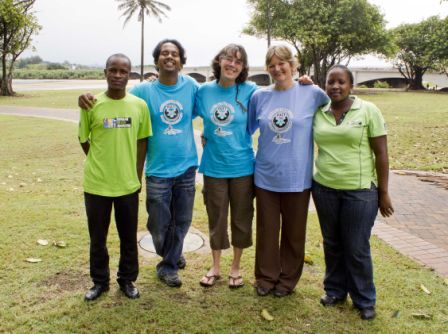The story of the Umgeni Estuary Conservancy really begins during late September 1987
I have at last found the post on the uMngeni Estuary Conservancy on the May Day for Rivers blog:
http://umngeniriverwalk.wordpress.com/conservancies/
Click on the link above to read about all the Conservancies along the uMngeni River; a wonderful collection. I repeat our post here for your interest.
Margaret Burger
UMGENI ESTUARY CONSERVANCY
The story of the Umgeni Estuary Conservancy really begins during late September 1987, when over 800mm of rain fell in the Durban area over a period of four days. The floodwaters peaked on 28th with the water level 5m above normal high tide level, travelling at over 6m per second, and discharging an estimated 17000 cubic meters per second. The result of this massive flooding on the uMngeni River in its estuary, was the disappearance of the island in the middle of the river, erosion of sections of the Windsor golf course, and the removal of most of the trees on the northern bank. The only tree left standing was the huge big-leaf fig, Ficus lutea at the bottom of Browns Drift Road. Riverside Road was closed for repairs for six months. This was an excellent time for a new beginning, and to start from scratch.






http://umngeniriverwalk.wordpress.com/conservancies/
Click on the link above to read about all the Conservancies along the uMngeni River; a wonderful collection. I repeat our post here for your interest.
Margaret Burger
UMGENI ESTUARY CONSERVANCY
The story of the Umgeni Estuary Conservancy really begins during late September 1987, when over 800mm of rain fell in the Durban area over a period of four days. The floodwaters peaked on 28th with the water level 5m above normal high tide level, travelling at over 6m per second, and discharging an estimated 17000 cubic meters per second. The result of this massive flooding on the uMngeni River in its estuary, was the disappearance of the island in the middle of the river, erosion of sections of the Windsor golf course, and the removal of most of the trees on the northern bank. The only tree left standing was the huge big-leaf fig, Ficus lutea at the bottom of Browns Drift Road. Riverside Road was closed for repairs for six months. This was an excellent time for a new beginning, and to start from scratch.

While the corporation busied itself with the reconstruction of the
northern bank by means of gabions, schools and other interested parties
planted indigenous trees and shrubs in among the rocks. At around the
same time, the Umgeni Estuary Concern Group was established by local
residents. The inaugural meeting was attended by Geoff Nichols and Johan
Bodenstein, both of whom proved invaluable with their input. From then
on the group busied itself with projects to improve the northern bank,
such as benches, bins, parking laybyes, rolltop curbing, alien invader
plant control, tree signage, trail map, creating bird, mammal and
butterfly lists and designing interesting
walks in their efforts to
ensure awareness of this
environmentally sensitive area.

The late Mike Milton who was employed by the old Natal Parks Board
then came into the picture. He had been given the task of setting up
Urban Conservancies, and produced a manual on how to go about it. What a
tower of strength he proved to be, and it was feather in his cap, when
the northern bank between the Beachwood Mangrove Reserve gate, and the
Connaught Bridge was declared the second urban conservancy in Durban on
11th February 1992. The fiddler crab was selected as our logo, a
constitution drawn up and a committee established who meet regularly
once a month still today.

Inanda Dam’s wall has been heightened and the lower uMngeni should
avoid floods of the likes of Demoina in future. However, we tackle very
different problems 20 years later. Mangrove trees are becoming
established on the islands replacing Juncus kraussiana and Phragmites australis,
a factor most likely contributing to a decline in migratory birds’
resting in the estuary as shown in the bi-annual water birds counts.
Homeless people seek shelter in this public open space. Our efforts at
clearing, solid pollution in the river, litter from pedestrians and
storm water debris eat away at our funds. We appeal to the Community
Policing Forums for assistance in controlling prostitution as well as
Lifeline and the Department of Health; the eThekwini authorities to
remove dumped rubble; trace industrial polluters; the Parks Department
to prevent pruning of verge trees and riparian vegetation for a better
view of the Moses Mabhida stadium.

We are now one of several role players with an interest in the
uMngeni River and estuary. The City of Durban has in its efforts to
accommodate climate change recognised the value of the uMngeni Estuary,
and established the Umgeni Green Precinct. The Dusi Umgeni Conservation
Trust is in a partnership with the Durban Green Corridor and tackles
invasive terrestrial and aquatic plants and litter. The Green Hub
situated on the south bank is the focus of sporting activities and
promotes eco-tourism in Durban. Surrounding communities have become
involved as River Rangers. A Working for the Coast team will soon
assist in invasive alien plant eradication as well as beach clean ups of
enormous magnitude each time it rains.

The uMngeni Estuary is the gateway to the Great Indian Ocean Gyre.
The pristine waters of the Mngeni Vlei eventually reach the estuary as a
mere ‘trickle’. Yet its beauty and value as an urban nature experience
is unsurpassed.
We wish the Umgeni River Fellowship a wondrous journey and look
forward to sharing the May Day for Rivers experience when they arrive in
our backyard on 27 May 2012.

Comments
Post a Comment